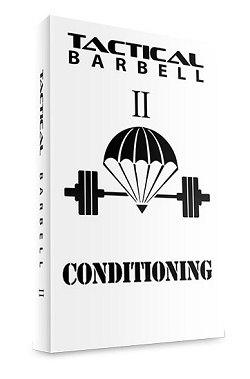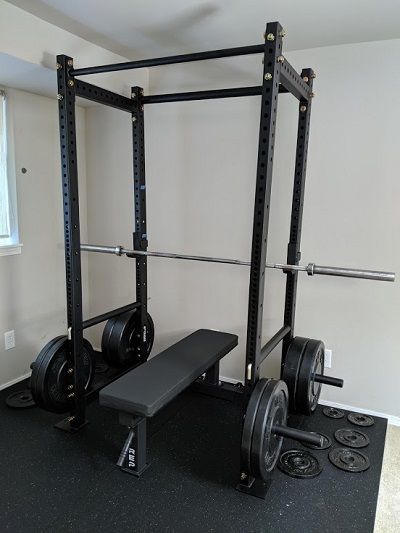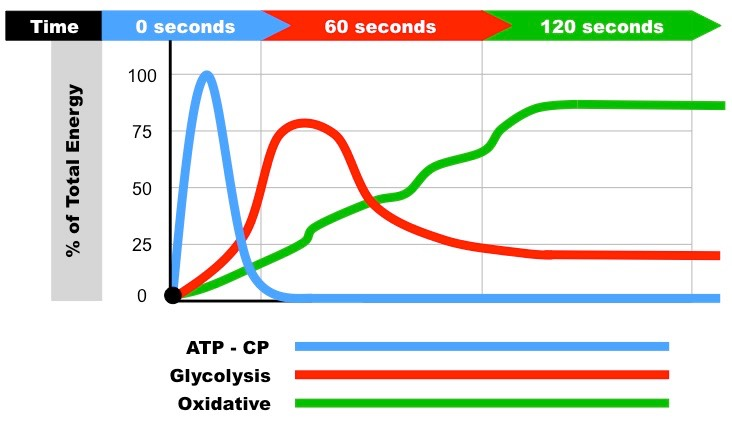Program & Book Review -- Base-Building from Tactical Barbell II by K. Black
A practical guide to developing aerobic and anaerobic conditioning.

I highly recommend this book for people who:
- want to incorporate more conditioning into their lifting regime
- want to develop an aerobic base or continue developing aerobic conditioning
- work in the military, law enforcement, or other physically demanding jobs
Buy Tactical Barbell II on Amazon
For more than a decade, lifting weights has been a huge part of my identity. Strength is my number one physical priority. When friends visit, they sleep on the couch--there’s a power rack where the guest bed should go.

*This is my 'guest bedroom'*
In the strength world, the closest you’re allowed to get to cardio is ‘conditioning’: short, high-intensity workouts. Think hill sprints, sled drags, tire flips. Workouts with plenty of breaks, and well under 20 minutes.
To do anything longer is to risk losing the most precious resource of all: your muscle. To speak of jogging is heresy. To whisper the word “m*rathon” requires a penance of 40 hours in the squat rack.
For a guy like me to put down the barbell, lace up my shoes, and go out for a run is bonkers.
So here’s my confession: I ran for 2 months.
Why? Have the evil agents of Broki poisoned my mind? Did I lose all my gains?
Cardio Kills Your Gains
K. Black’s Tactical Barbell II is all about conditioning: training the body’s energy systems to be ready for some future situation, whether it’s competition, engaging in combat, or sprinting to catch the bus.
In an unusual move, K. Black begins his conditioning book with a discussion on low-intensity steady-state cardio (LISS). Think jogging, cycling, or rowing at a comfortable pace for at least 30 minutes. His target audience: people like me, who regard cardio as an unholy sin.
If you learned to lift weights on the internet you know that cardio kills your gains. If you want to be strong, LISS seems completely out of place. What does jogging have to do with lifting a maximal weight?
Like everyone else, K. Black also knew that cardio kills your gains. As soon as he got out of mandatory military runs, he dropped cardio completely. His new regimen: lifting, high intensity interval training, no LISS. Just as prescribed by the internet. What he found wasn’t so encouraging:
“Operations were becoming tiring...Now I felt fatigued, far more fatigued than I should have...I just felt plain tired most of the time. In the weight room, I was just going through the motions.”
The author was doing less work and feeling more fatigued. He was following the established advice and not getting anywhere. What went wrong?
The only difference was the dropped cardio. After much introspection, K. Black decided to try reincorporating cardio again:
“Surprisingly, my muscle did not disappear. I had no reduction in maximum strength. On the contrary, I had far more energy with the barbells...The only change I had made in my training was the intelligent addition of long steady state, aerobic training.”
Huh.
As a wake-up call, the author provides a short checklist:
“You’ll benefit from aerobic training if any of these apply to you:
- Your resting heart rate is in the 60s or higher.
- You have a slower 1.5 Mile/Cooper’s run (roughly, anything over 9:30 / 10 minutes)
- You can’t run for 3 miles without stopping.”
Every single one of these applied to me. I wasn’t even sure I could complete a 1.5 mile run.
This sounded like a good opportunity to try something I hated. But first, excessive internet research!
Does cardio really kill your gains?
The “cardio kills your gains” trope isn’t completely unfounded. Excessive amounts of running does impair recovery from strength training and hypertrophy (Wilson 2012).
However, that doesn’t mean we should totally ignore cardio.
The truth is, you use your aerobic system way more than you’d think. A trip to any Exercise Physiology 101 textbook will show that all of your energy systems are being used during any activity. This isn’t a video game where you can take all of your ‘endurance’ skill points and transfer them to the ‘strength’ skill.
“Your aerobic system provides the majority of energy for most activity. Isn’t this a good thing even if we’re not talking about running? I’m guessing you want to be unfatigued for ‘most activity’”

*Although it’s a small contribution, the aerobic system (green) does contribute to and increase output during anaerobic activity!*
In his article Avoiding Cardio Could be Holding You Back, Greg Nuckols explains why lifters would benefit from an appropriate level of cardio.
Briefly:
- Lifting uses more of the aerobic system than you’d think, especially in training
- Only low intensity cardio work can provide certain improvements in aerobic system, namely cardiac enlargement and oxygen carrying capacity. Interval training does not induce these changes
- An improved aerobic system means faster recovery from anaerobic workouts like lifting
“Although you’re obviously very reliant on your anaerobic system when you’re actually lifting the weights, what energy system do you think you use to recover between sets?” - Greg Nuckols
I read this article when it came out (2015!), nodded my head, then proceeded to do zero cardio. This concept that cardio==bad was so entrenched it took me four years to reverse a faulty position!
Okay, so there’s actually some basis for lifters to use low intensity cardio. Let’s read this book and try it out.
Book Review: Tactical Barbell II
K. Black’s Tactical Barbell series is strength and conditioning for the special ops military guy, the SWAT officer, the firefighter. With program names like ‘Operator/Black’ and ‘Zulu/Green,’ the whole package screams tacticool. The book includes photos of dudes in all black storming buildings, crawling through swamps, and rucking through the desert.
It’s not my aesthetic. I am a tacti-un-cool desk jockey. Initially I was pushed away by the military framing. Oddly enough, this framing allows the book to work for more people, not less.

*Tactical Barbell II Reader*
There’s something great about K. Black that’s really rare in this industry: he understands that you have different goals, lifestyles, and contexts than he does. Most authors in this genre assume you’re a twenty-something male whose life is dedicated to the barbell. Because this book is focused on military and law-enforcement, it’s forced to address different contexts. A deployed soldier can’t handle the same training that a pencil pusher back on base can. Depending on their mission, some soldiers need a ton of endurance, while others need to pour everything into strength. Tactical Barbell repeatedly reminds you to remember your personal context:
“Take any conflicting information in context. A champion powerlifter is telling you not to do long steady state running? He might be right. For his situation and goals. Not necessarily yours.”
Also great, the author understands the importance of fundamentals, and offers a framework for structuring long term training based around that. He implores you to make sure the fundamentals are solid before getting specific:
“First base-build, then advance high priorities and maintain low priorities.”
Lastly - and I absolutely love this - K. Black doesn’t claim his method is the best program ever. He doesn’t get into the weeds dissecting irrelevant details. He doesn’t care if you use his strength programming or someone else’s, if you run or swim or do martial arts. He says that “the fitness domain you’re training is the important thing, the tools are secondary.”
The book simply outlines what worked for the author and his clients. It’s a sane default. Later he encourages you to tweak it to fit your own needs.
Program Review: Base-building
Tactical Barbell II outlines a framework for training with three parts:
- Base-building - build a foundation of general endurance and strength
- Continuation - Pursue your main fitness goals
- Maintain - Periodically work on lower priority fitness domains to maintain them
First up is a ‘base-building’ phase. It’s 8 weeks dedicated to improving aerobic energy systems. The bulk of the work is slow jogging, increasing time spent moving as the weeks go on (other forms of cardio are acceptable here). The main goal is cardiac enlargement and improvement of oxygen carrying capacity. Also included is some ‘strength endurance’ work to develop other aspects of the aerobic system. I completed a base-building phase and will discuss my results below.
There’s nothing revolutionary here, no crazy hacks or secrets. This type of base-building is typical for endurance athletes, who put “miles in the bank” before incorporating speed work or intervals.
Towards the end of base-building, the training shifts away from longer cardio sessions and starts incorporating heavier lifting workouts, assuming you’re going to be shifting towards more strength-focused work.
The Results of Base-Building
I started base-building in early July and finished 8 weeks later, only missing two out of 40 workouts.
Remember, I’ve hated cardio my entire life.
The first two weeks were not fun. My legs hurt, my lungs hurt, and my ego hurt. ‘Running’ is not a great description of what I was doing; ‘old man shuffle’ might be more appropriate.
To get through it, I used a mantra borrowed from Callum Flack: "running is the greatest high I know". I’d repeat it over and over: running is the greatest high I know, running is the greatest high I know.
I didn’t believe it.
What I did believe was that it would get easier. I just had to keep showing up.
Sometime in week 3 something started happening. I got home from work one day and realized, “hey, I’m looking forward to my run!”
Improvements came fast. On week 4, I ran for an hour without stopping. I had never done that before.
I dropped the mantra, because it had come true. I finally felt the runner’s high.
Energy benefits
Base-building had a positive impact on my general energy levels:
- I feel great during and after a slow run like this
- I have much more energy after work - I do extra chores around the house because I'm itching to get up and move
- I feel less fatigued the day after training, and seem to need less rest between sets of heavy squats.
Mental benefits
Long distance runs offer a different kind of mental training than I’m used to. ‘One step at a time’ is a bit of a cliche, but every run I am surprised how much distance I cover. Training like this is proof that I can keep going much longer than I think, no matter what the activity. 15 minutes of plowing through email is nothing compared to an hour on the pavement.
The repetitive nature and lack of digital stimulation provides a nice environment to clear my head. Running provided an excuse to be outside for an extended period of time. I’m lucky to live by some nice trails, as exposure to plants has physical and mental health benefits (Ideno 2017, Hansen 2017).
On rest days I’d notice myself getting a bit cranky. Was this me returning to baseline, or a negative effect from the training? I’m unsure.
Overall, running has improved my mental state.
The costs
How much did it cost me to try Tactical Barbell’s base-building?
- $10 - Tactical Barbell II
- $11 - Cheapo watch for timing runs
- ~30 hours of training - 40 workouts
- 2 months of time not increasing strength
I maintained weight throughout the 2 months, and look leaner.
Reprise
Was putting away the barbell to run for 8 weeks worth it? Yes.
Going forward, I’ll be making two changes to the way I train:
- I’ll incorporate a small amount of jogging to maintain cardiovascular fitness (~30m 1x/week)
- I’ll continue doing a base-building phase like this once a year.
There’s nothing crazy about what I did. Thousands of people do this sort of aerobic base-building routinely. But for me it was a good reminder--my identity is malleable, and I can shape it with a few weeks of new behavior. Just because my focus is strength doesn’t mean I have to completely neglect other areas of physical health. The “rules” I have internalized are simple guidelines, waiting to be broken when needed.
What activity could you undertake that breaks some of your “rules”? Are you avoiding cardio to save your muscles? Are you a distance runner who avoids the weight room? Let me know.
Buy Tactical Barbell II on Amazon.
Further Reading
- You Are Holding Yourself Back
- Avoiding Cardio Could Be Holding You Back - via Stronger by Science
- Miles in the Bank - via Cool Running
- "Omg why didn’t anybody tell me about this" - video via @visakanv




Member discussion